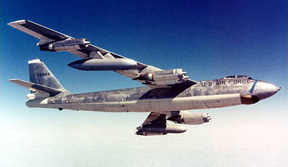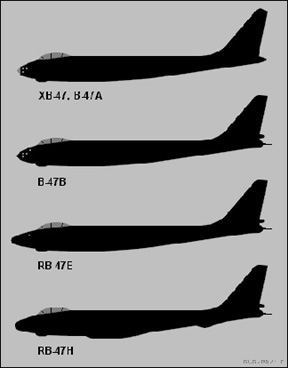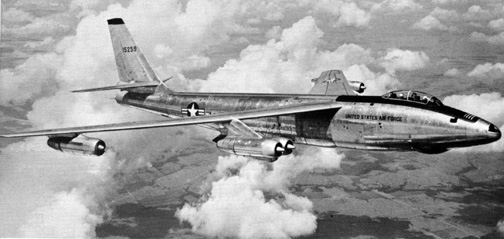|
Relating to The Earl E. Myers Story Attachment to Chapter 23 Page 2 of 3 Pages |
|||||||||||
| * The designations "B-47C" and "B-47D" were applied to special variants that never went into production, and so the next production version of the B-47 was the definitive "B-47E". |
|||||||||||
| A total of 1,341 B-47Es were produced. 691 were built by Boeing, 386 were built by Lockheed, and 264 were built by Douglas. Most B-47Bs were rebuilt up to B-47E standards. They were given the designation of "B-47B-II", though it appears that in practice they were simply called B-47Es. |
|||||||||||
 |
|||||||||||
|
RB-47E / RB-47H / ERB-47H / RB-47K
|
|||||||||||
| * The B-47E was also the basis for a number of important long-range reconnaissance variants.
Boeing-Wichita built 240 "RB-47E" reconnaissance variants, similar to the B-47E but with a nose stretched by 86 centimeters (34 inches), giving them an arguably more elegant appearance than the bomber variants of the B-47. The long nose was used to stow up to 11 cameras, which could include: * An O-15 radar camera for low-altitude work. |
|||||||||||
 |
|||||||||||
| The RB-47E could carry photoflash flares for night reconnaissance. Although the RB-47E could be refueled in flight, its fuel capacity was increased, to a total of 70,000 liters (18,400 gallons). The navigator controlled the cameras, becoming a "navigator-photographer" instead of a "navigator-bombardier". |
|||||||||||
 |
|||||||||||
|
Photo Ctsy. The Boeing Company |
|||||||||||
| * A total of 32 "RB-47H" models were built for the electronic intelligence (ELINT) mission, as well as three more specialized "ERB-47Hs". These aircraft featured distinctive a blunt, rounded nose and sported blisters and pods for intelligence-gathering antennas and gear. They were designed to probe adversary defenses and then collect data on radar and defense communications signals.
The bombbay was replaced by a pressurized compartment, which accommodated "electronic warfare officers (EWOs)", also known as "Crows" or "Ravens". There were three Crows on board the RB-47H, but only two on the ERB-47H. A distinctive bulged fairing replaced the bombbay doors. The RB-47H / ERB-47H retained the tail turret, and were also fitted with jammers and chaff dispensers. The only easily recognizable difference in appearance between the RB-47H and ERB-47H was that the ERB-47H had a small but distinctive antenna fairing under the rounded nose. The first RB-47H was delivered in August 1955. The ELINT B-47s proved so valuable that they were put through a "Mod 44" or "Silverking" update program in 1961 to provide them with updated electronics systems. Silverking aircraft could be easily recognized by a large teardrop pod for ELINT antennas attached to a pylon, mounted under the belly and offset to one side of the aircraft, as well as an pylon-style antenna attached under each wing beyond the outboard engine. It is unclear if all RB-47Hs and ERB-47Hs were updated to the Silverking specification. * The RB-47H and ERB-47H were highly capable aircraft, but the EWO compartment was not only cramped, with sitting room only, but had both poor noise insulation and climate control. This made long missions very uncomfortable and tiring, and some sources say that the Crows even had to deal with fuel leaks on occasion. Getting out in an emergency was also a problem. The Crows had ejector seats that would literally cut a hole through the fairing in the bottom of the compartment when fired, but nobody regarded such a scheme as very credible. Operations of the RB-47H and ERB-47H were top secret, with the missions generally flown at night and even base commanders often not knowing what they were all about. When crews were asked what they were doing, they always answered that such information was classified. On inquiries on what the blunt black nose was for, they would sometimes reply that it was a bumper, used in in-flight refueling in case they nosed into the tanker. This reply was often believed. While a few of these aircraft performed special duties during the Vietnam war, such as relaying ELINT data from drones, they were eventually replaced by much more comfortable and capable Boeing RC-135 platforms. The last RB-47H was retired on 29 December 1967. * The final 15 RB-47Es built were fitted with additional equipment, including a "side looking airborne radar (SLAR)" system, and gear to sample the air for fallout from nuclear tests. The Air Force judged them different enough on delivery, beginning in December 1955, to give them a new designation of "RB-47K". The RB-47Ks were generally used for weather reconnaissance missions, carrying a load of eight "dropsonde" weather sensors that were released at various checkpoints along the aircraft's flight path. Data radioed back from the dropsondes was logged using equipment operated by the navigator. The RB-47Ks stayed in service until 1963. * Incidentally, there were "F", "G", and "J" B-47 variants, but these were all one-shot conversions of B-47Bs or B-47Es. There never was a "B-47I" variant. The Air Force didn't use the "I" suffix because it was too easily confused with "1". End of Page 2 of 3 Pages — Go to Page 3, B/RB-47 Hist. Go to EEM Introduction —Chapter 1 — 2 — 3 — 4 — 5 — 6 — 7 — 8 |
|||||||||||